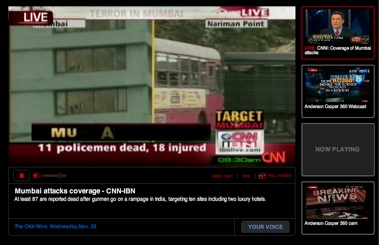
The terrorist attacks in Mumbai played out not only on cable networks but for the first time since the election on computer screens. CNN offered a live feed at the top of its Web site that required downloading Flash 10 to operate. The beta client is reminiscent of the Olympics Silverlight client, which allowed switching between multiple feeds. In this new coverage, you could switch between CNN International and several CNN affiliates, including CNN IBN, the Indian sister network reporting locally about new attacks not yet visible on the main network, as well as a no-audio behind the scenes look at the Anderson 360 set in New York.
As the coverage continued, one British lawyer at a hotel currently under attack talked via phone from his barricaded room. He told CNN anchor Jonathan Mann that the hotel guests were communicating via Blackberry and cell phone. Mann belatedly realized he was asking questions – How close are you to the fires in the building? – that could alert the attackers to the guest’s location, and asked him to mot give any more details that might give away his position.
In an earlier segment, an academic from the University of California at Berkeley was interviewed via cell phone and what looked like a Webcam video feed. Twitter was mentioned numerous times by Mann and other reporters as an early and continued source of information about the violence. Over at competitor MSNBC there was no live feed, but ongoing video updates, one of which was embedded on a Mahalo page and then tweeted on the micromessaging service.
FriendFeed does not yet support realtime feeds of its search functionality, but even at this early stage of the service it took 30 pages of messages to go back 20 minutes in time. Robert Scoble and a swarm of FriendFeeders loaded an alpha PeopleBrowsr that aggregated Twitter messages, Flickr images, and YouTube videos, though within 30 minutes it had slowed to a crawl. And while the CNN main feed concluded with the announcement that the government was now in control, the IBN network was reporting negotiations still underway inside the hotels.
Watching cable news seems to be in a major transition, as breaking news seems to be an excuse to move relatime coverage to the Web. Earlier today I watched the complete Obama press conference on demand on MSNBC and only switched to CNN when I realized they had both on demand and realtime coverage. Both the Flash 10 code and CNN Live are in beta, so it’s not clear whether this is a planned rollout or one that was accelerated by the attacks. What’s sure is that social media and news are merging before our eyes.